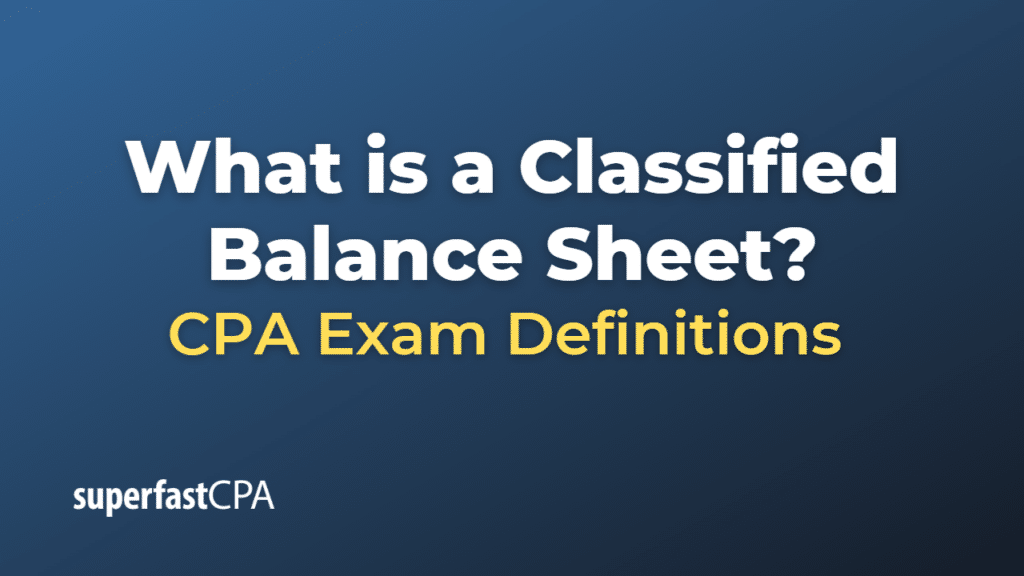Classified Balance Sheet
A classified balance sheet is a financial statement that presents a company’s assets, liabilities, and equity in an organized and easy-to-understand format, with the items classified into specific categories. The purpose of a classified balance sheet is to provide a clear and concise snapshot of a company’s financial position at a given point in time, making it easier for investors, creditors, and other stakeholders to analyze the financial health of the business.
The classified balance sheet separates assets and liabilities into current and non-current (long-term) categories. This classification is important because it helps users understand the company’s liquidity and solvency, as well as its ability to meet short-term and long-term obligations.
Here are the main categories used in a classified balance sheet:
- Current Assets: These are assets that are expected to be converted into cash, sold, or consumed within one year or the company’s operating cycle, whichever is longer. Examples of current assets include cash, cash equivalents, accounts receivable, inventory, and short-term investments.
- Non-Current (Long-term) Assets: These are assets that are not expected to be converted into cash, sold, or consumed within one year or the company’s operating cycle. Examples of non-current assets include long-term investments, property, plant and equipment, and intangible assets (e.g., patents, trademarks, goodwill).
- Current Liabilities: These are obligations that are expected to be settled within one year or the company’s operating cycle, whichever is longer. Examples of current liabilities include accounts payable, short-term debt, accrued expenses, and deferred revenue.
- Non-Current (Long-term) Liabilities: These are obligations that are not expected to be settled within one year or the company’s operating cycle. Examples of non-current liabilities include long-term debt, deferred tax liabilities, and pension obligations.
- Shareholders’ Equity: This represents the residual interest in the company’s assets after deducting its liabilities. Shareholders’ equity typically consists of issued share capital, retained earnings, and other components such as treasury stock and accumulated other comprehensive income.
By presenting the balance sheet items in these categories, the classified balance sheet provides a clearer picture of a company’s financial position, making it easier for users to assess its liquidity, solvency, and overall financial health.
Example of a Classified Balance Sheet
Let’s create a simple example of a classified balance sheet for a fictional company, “TechWidget Inc.” Assume the following financial information (in thousands of dollars) as of December 31, 2023:
Current Assets:
- Cash and cash equivalents: $50,000
- Accounts receivable: $30,000
- Inventory: $20,000
- Prepaid expenses: $5,000
Non-Current Assets:
- Property, plant, and equipment (net): $100,000
- Intangible assets (net): $25,000
Current Liabilities:
- Accounts payable: $15,000
- Short-term debt: $10,000
- Accrued expenses: $7,000
- Deferred revenue: $3,000
Non-Current Liabilities:
- Long-term debt: $70,000
- Deferred tax liabilities: $10,000
Shareholders’ Equity:
- Common stock: $50,000
- Retained earnings: $40,000
Now, let’s present this information in a classified balance sheet format:
TechWidget Inc.
Classified Balance Sheet
As of December 31, 2023
(All figures in thousands of dollars)
Assets
Current Assets:
Cash and cash equivalents $50,000
Accounts receivable $30,000
Inventory $20,000
Prepaid expenses $5,000
Total Current Assets $105,000
Non-Current Assets:
Property, plant, and equipment $100,000
Intangible assets $25,000
Total Non-Current Assets $125,000
Total Assets $230,000
Liabilities
Current Liabilities:
Accounts payable $15,000
Short-term debt $10,000
Accrued expenses $7,000
Deferred revenue $3,000
Total Current Liabilities $35,000
Non-Current Liabilities:
Long-term debt $70,000
Deferred tax liabilities $10,000
Total Non-Current Liabilities $80,000
Total Liabilities $115,000
Shareholders’ Equity:
Common stock $50,000
Retained earnings $40,000
Total Shareholders’ Equity $115,000
Total Liabilities and Shareholders’ Equity $230,000
In this example, the classified balance sheet provides a clear and organized overview of TechWidget Inc.’s financial position as of December 31, 2023. By categorizing assets and liabilities as current or non-current, it allows users to quickly assess the company’s liquidity, solvency, and overall financial health.












